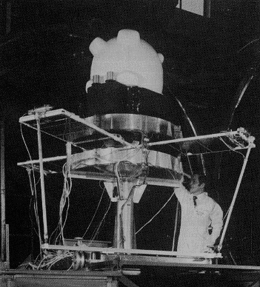Ariel 6
 Ariel 6 before launch | |
| Mission type | Astronomy |
|---|---|
| Operator | SERC / NASA |
| COSPAR ID | 1979-047A |
| SATCAT № | 11382 |
| Mission duration | 2 1⁄2 years |
| Spacecraft properties | |
| Manufacturer | Marconi |
| Launch mass | 154.5 kilograms (341 lb) |
| Start of mission | |
| Launch date | 2 June 1979, 23:26:00 UTC |
| Rocket | Scout D-1 S198C |
| Launch site | Wallops LA-3A |
| End of mission | |
| Deactivated | February 1982 |
| Decay date | 23 September 1990 |
| Orbital parameters | |
| Reference system | Geocentric |
| Regime | Low Earth |
| Eccentricity | 0.00328 |
| Perigee | 599 kilometres (372 mi) |
| Apogee | 653 kilometres (406 mi) |
| Inclination | 55 degrees |
| Period | 97.22 minutes |
| Epoch | 15 July 1979[1] |
Ariel 6, also known as Ariel VI and UK-6, was a British satellite launched in 1979 as part of the Ariel programme. It was operated by the Science Research Council, which became the Science and Engineering Research Council in 1981. Ariel 6 was used for astronomical research, and operated until February 1982.[2] It was the last Ariel satellite to be launched.[3]
The spacecraft was manufactured by the Marconi Company, and had a mass of 155 kilograms (342 lb). It carried three instruments; two of which were used for x-ray astronomy, and one which was used to detect cosmic rays. Interference from radar signals prevented the satellite from pointing correctly, and affected the data that it returned.[2]
A Scout D-1 carrier rocket, serial number S198C, was used to launch Ariel 6 from Launch Area 3A at the Wallops Flight Center. The launch was successfully conducted at 23:26:00 UTC on 2 June 1979.[4][5] The satellite was placed into a low Earth orbit, and received the International Designator 1979-047A.[3]
Ariel 6 operated in a 599 by 653 kilometres (372 by 406 mi) low Earth orbit, at an inclination of 55 degrees and with an orbital period of 97.22 minutes as of 15 July 1979.[1][6] It decayed from orbit and reentered the atmosphere on 23 September 1990.[1]
See also
References
- 1 2 3 McDowell, Jonathan. "Satellite Catalog". Jonathan's Space Page. Archived from the original on 9 June 2010. Retrieved 6 December 2013.
- 1 2 "The Ariel VI Satellite". HEASARC. NASA. Retrieved 4 June 2010.
- 1 2 "Ariel 6 Spacecraft Details". NSSDC Master Catalog. NASA. Retrieved 4 June 2010.
- ↑ Krebs, Gunter. "Ariel 6 (UK 6)". Gunter's Space Page. Retrieved 4 June 2010.
- ↑ McDowell, Jonathan. "Launch Log". Jonathan's Space Page. Archived from the original on 7 May 2010. Retrieved 3 June 2010.
- ↑ "Ariel 6 Launch Information". NSSDC Master Catalog. NASA. Retrieved 4 June 2010.